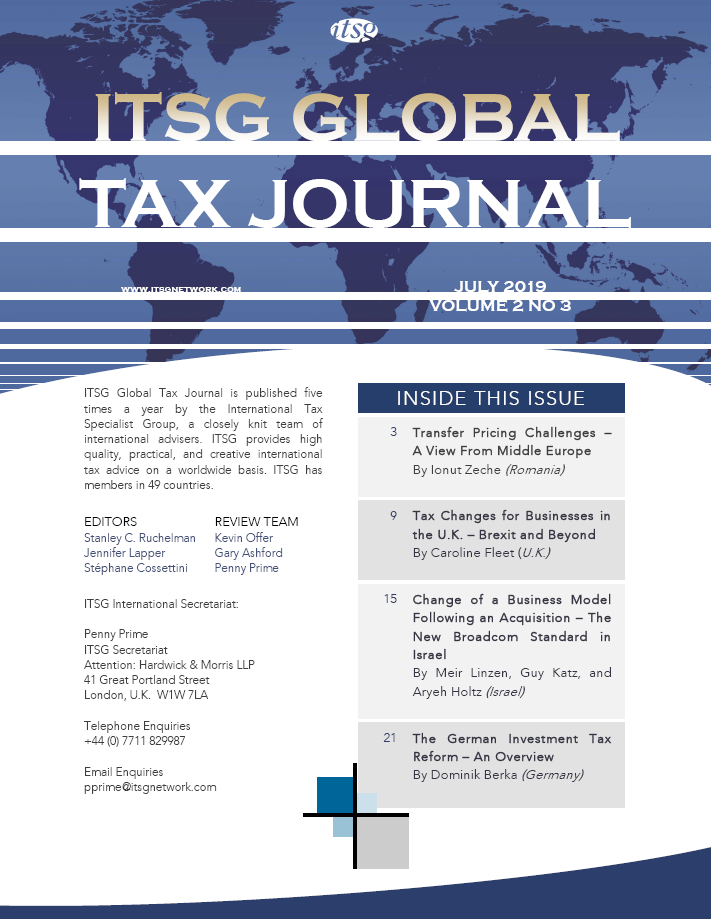As one might expect, the issue of Brexit, the U.K.’s withdrawal from the European Union, has been at the centre of everyone’s thinking for some time – from policymakers and business leaders to investors and consumers, both in the U.K. and abroad, the topic cannot be avoided.
As of summer 2019, the terms of how Brexit will be delivered remain to be decided, which has led to further uncertainty for those business leaders who are tasked with planning for the future and delivering their business plans in an uncertain landscape.
However, while Brexit has undoubtedly caused business leaders to reassess how they will operate in the future, both in the immediate aftermath and longer-term, it is easy to forget that there are a number of changes – particularly to the tax world – which need to be considered, no matter what occurs with Brexit within the next few months.
Here, we provide an overview of some of the main corporate tax changes that have occurred in recent months and will be taking place over the next year, identifying those entities that will be affected and suggesting action steps for required by those entities in order to remain compliant with ever-changing tax law.
Making tax digital (M.T.D.)
M.T.D. is expected to be the most fundamental change to the tax administration system for at least 20 years, and organisations should be aware that the V.A.T. changes are just the starting point. M.T.D. was introduced by H.M.R.C., the U.K. tax authority, to simplify tax returns and propel the U.K. forward as a world-leading digital tax authority. Naturally, M.T.D. similarly created a lot of noise within the media, particularly around the timeframes involved and whether U.K. business – especially small and medium-sized enterprises – were prepared to meet the April 2019 deadline.
V.A.T. is at the forefront of the M.T.D. initiative and, from 1 April 2019, all organisations with a turnover above the V.A.T. threshold (£85,000) are required to keep their V.A.T. records digitally and submit their V.A.T. data to H.M.R.C. through compatible software.
For many businesses, this presented a significant change to pre-existing V.A.T. processes and procedures, especially if they relied heavily on spreadsheets in order to meet the V.A.T. reporting obligations. The changes capture almost all U.K. V.A.T.-registered persons, whether the organisation is (i) charitable or trading or (ii) established domestically or overseas. It may be a greater challenge for overseas organisations to comply with M.T.D. for V.A.T. as their U.K. activities are likely to be a single part of a larger activity. This could also be the case for U.K. organisations that are part of international groups required by their overseas head offices to operate specific accounting or reporting processes and software.
M.T.D. is likely to have far-reaching implications, as it applies to any V.A.T. registered U.K. business from 1 April. Given the timeframe, H.M.R.C. has issued guidance1, particularly with regard to areas such as compatible software.
While there may be very few outright exemptions, H.M.R.C. has indicated that there will be a “soft landing” period between April 2019 and April 2020 for organisations to have in place digital links between all parts of their functional compatible software. For this first year, organisations are generally not required to have digital links between software programs. The submission of the V.A.T. return to H.M.R.C. is excluded from this relaxation, though, and must be done digitally with effect from April 2019.
As noted above, these V.A.T. changes are only the beginning of the process, and whilst H.M.R.C. have indicated that the earliest that M.T.D. will apply for direct tax purposes will be from April 2021, the trend toward digital tax administration is clear.
Non-resident capital gains tax (N.R.C.G.T.)
All disposals of residential or non-residential real property in the U.K. by non-residents have been brought within the scope of U.K. capital gains tax as of April 2019. In addition, disposals of “property or land rich entities” (i.e., entities where 75% or more of the gross asset value is derived from U.K. land) now also fall within the scope of U.K. capital gains tax, where the non-resident and connected parties owned more than 25% interest in the entity in the two years prior to the disposal. There is an exemption from the tax where the land is used for the purposes of a qualifying trade before the disposal and it is intended to continue to be used for the trade after the disposal. This exemption will assist certain sectors, such as hotels, care homes, and serviced office accommodations. Where the tax applies, the land interests and appropriate shareholdings will be treated as being rebased on 1 April 2019. Any capital gains which accrue on an uplift in value after April 2019 will be subject to U.K. capital gains tax. For corporate entities, this will be charged at the rate of U.K. corporation tax, currently 19% and scheduled to be reduced to 17% in 2020.
There are also specific provisions with respect to collective investment schemes investing in U.K. land, which allows such entities to be treated as either exempt in certain circumstances or transparent. This may well mean that offshore trust structures become popular again, as they allow for this flexibility. However, overall, what this new legislation will do is further level the playing field between offshore and onshore investment in U.K. property.
Non-resident corporate landlords holding U.K. property
Going forward, corporate entities will no longer be subject to income tax on income received from U.K. property.
Instead, from 1 April 2020, non-resident companies will be subject to a 19% corporation tax (reducing to 17% in 2020) on any income or capital gains that arise from U.K. property. This applies to non-U.K. companies that receive rental income or make a capital gain on the sale of U.K. property (note that from April 2019, such companies already pay corporate tax on their capital gains).
This means that companies must take into account the transitional rules between income tax and corporate tax and the implications of being a corporate taxpayer. For many companies this will mean consideration of the corporate interest restrictions rules (broadly, since April 2017, restrictions can be placed on interest deductions where a corporate group reports more than £2 million net interest expense during the year), the anti-hybrid legislation, as well as potentially falling within the quarterly payment regime. Again, coupled with the N.R.C.G.T. for all U.K. land, the benefit of holding U.K. land in offshore entities is reduced substantially.
Corporate tax losses
New legislation has introduced more flexibility in the use of corporate tax losses. Losses arising after 1 April 2017 can be carried forward and be set against most types of taxable profits of the company and other group members, irrespective of the activity associated with the losses. Losses generated prior to 1 April 2017 still face restrictions on how they can offset profits.
The new rules, however, introduce a restriction on the use of losses. A group relief group (broadly 75% or more corporate group) can offset losses up to a value of £5 million. Above the £5 million allowance only 50% of the profits can be offset by carried-forward losses, irrespective of when the losses arise.
H.M.R.C. has also now published draft legislation that will mean that from 1 April 2020 capital losses will be brought within the new loss restriction rules and the same £5 million allowance.
Changes in capital allowances (Depreciation of assets for tax purposes)
On 1 January of this year, capital allowance changes came into effect, which were introduced by the government to stimulate business. The capital allowance annual investment allowance, which provides 100% relief in the year of acquisition, increases to £1 million (previously £200,000) for qualifying expenditures for the two-year period from 1 January 2019 to 31 December 2020. The main pool capital allowance rate remains at 18% writing down allowance per year. Whereas, the capital allowance special rate allowance was reduced from 8% to 6% per year from April 2019.
In addition, a new capital allowance was created for the construction costs of non-residential property applicable to the structure and building. Historically there has been no tax-deductible depreciation for the main structure and framework of such buildings. Going forward, however, a 2% annual deduction is available on construction costs of non-residential properties incurred after 29 October 2018. Interestingly, unlike other capital allowances, there is no balance charge or allowance on the disposal of the asset during its 50-year life. Rather, the relief passes to the new owner, and the allowances claimed are then deducted from the basis of the capital gains on the disposal of this asset. The latter is a feature often more commonly associated with other European tax regimes.
Corporate intangible fixed assets: Goodwill
Tax relief for goodwill was withdrawn for disposals on or after 8 July 2015. The government has now reinstated the relief for the costs of “acquired goodwill”, an intangible asset that arises when a buyer acquires an existing business. Under the new legislation, relief will be available for up to six times the value of eligible intellectual property (I.P.) assets acquired with the business.
The main categories of eligible assets are:
- Patents
- Registered trade marks
- Registered designs
- Copyright and design rights
- Plant breeders’ rights
Customer-related intangibles are not included.
Relief for eligible goodwill will be based on a fixed rate of 6.5% of the cost per year, rather than on an accounting basis. No relief will be available in relation to internally-generated goodwill acquired in relation to a related-party transaction. This tax relief applies to goodwill acquired after 1 April 2019 for any business acquiring a third-party business that includes goodwill as part of the consideration for payment.
Profit fragmentation anti-avoidance
Following the budget in 2017, the government introduced legislation to tackle tax avoidance involving the fragmentation of business profits. The proposed rules prevent companies, partners, or U.K. individuals from moving profits offshore by way of a “transfer of value” to a low-tax entity resulting in less U.K. tax being paid. This could be by decreasing U.K. income or increasing U.K. expenses.
The rules apply where the U.K. individual or someone connected with them then benefits from those offshore profits. When considering whether there has been a transfer of value from a business, the transfer can be traced through any number of individuals, companies, partnerships, trusts, or other entities.
The rules include an 80% payment test, comparing the tax suffered on the alienated profits against that due in the U.K. Broadly, a U.K. tax mismatch adjustment will be required where the tax paid offshore is less than 80% of that which would be due in the U.K.
Under these anti-avoidance rules the fragmented profits are taxed as U.K. profits, with payment of tax being due 30 days after H.M.R.C. issues a preliminary notice of taxation.
The rules apply to any company or individual shifting profits offshore from 1 April 2019 for companies or 6 April 2019 for individuals.
Withholding taxes
The U.K.’s current withholding tax regime has been extended to royalty payments and payments for certain other I.P. rights. A 20% withholding tax will be applied where (i) payments relating to the exploitation of I.P. rights and other property rights in the U.K. are made to related parties and (ii) the recipient company is in a country which does have a double tax treaty with a non-discrimination article.
Where the rules apply, they will potentially create a significant additional tax and administrative burden for businesses. These rules are clearly aimed at the large global brands which have a significant U.K. sales presence and apply from 1 April 2019 and will affect such businesses paying royalties to low tax jurisdictions in relation to U.K. sales.
Research and development (R&D) tax relief
R&D reliefs help companies that work in sectors such as technology, manufacturing, healthcare and biotechnology, property, construction, engineering and professional practices, to research or develop concepts in their field and can even be applied to those projects which are ultimately unsuccessful. It can be applied if a business is:
- Developing new or improved products or processes
- Investing in technology
- Investing in software which helps a business to run more efficiently
Businesses that are involved in R&D can claim tax relief to either lower their tax bill or if they have tax losses, these can be surrendered for cash from H.M.R.C.
Small and medium companies can claim additional relief of up to £33.35 for every £100 of qualifying R&D spend. For profitable companies, the additional relief can help reduce the corporate tax bill, while for loss-making organisations, the additional relief can be used to claim cash back from H.M.R.C., which improves cashflow and can increase company reserves.
From 1 April 2020, the amount of repayable cash credit claimable from H.M.R.C. in any one year will be restricted to three times the company’s total PAYE/NIC bill for the year. The provision is intended to target the relief to companies that have a workforce in place.
Any tax loss that is restricted and cannot be surrendered for a repayable credit can be carried forward against future profits. This is most likely to affect start-up companies who often don’t pay Directors/owners significant salaries during the early years.
Entrepreneurs’ relief (E.R.)
Entrepreneurs who sell their business (or ‘qualifying assets’), may be able to claim E.R. This applies when an entrepreneur wishes to sell or dispose of part, or all of a business in its entirety. E.R. applies a flat rate of 10% capital gains tax on the sale of shares in a trading company or group where the shareholder is:
- both an employee/director, and
- holds no less than 5% of the issued shares immediately prior to sale.
However, from 6 April 2019, individuals whose shareholding is diluted below 5% as a result of a new share issue will get relief for gains up to the date of dilution. H.M.R.C. has announced measures designed to ensure that “entrepreneurs are not discouraged from seeking external investment to finance business growth in circumstances where their own shareholding becomes diluted.” What this means is that certain shareholders will be able to bank E.R. up to the time of the dilution event and will have an option to defer the tax payment if they wish. The benefit of deferring the tax liability must be weighed against the risk of a change in circumstances (for example retirement) and/or a change in the E.R. rules, which may prevent the relief from applying.
Digital services tax (D.S.T.)
With the growth of digital economy expanding exponentially, governments across the world have been attempting to address an aging tax system so that it can be applied to new ways of trading, where digital giants operate across many jurisdictions. An additional problem is that many of these giants do not create traditional products or offer traditional services. As a result, imposing tax on value creation is extremely difficult.
In the 2018 Autumn Budget, the U.K. made the first foray into this area by looking to introduce a unilateral D.S.T. The O.E.C.D. subsequently followed suit and has recently put forward plans to modernise the global tax system, proposing fundamental changes to how companies will be taxed. Following the consultation, in July 2019, H.M.R.C. has now published draft legislation in respect of this proposed tax.
The U.K.’s D.S.T., introduced at a rate of 2%, will apply to businesses generating global revenues of more than £500 million and with U.K. revenues of at least £25 million from relevant activities. It will apply to businesses deriving revenue from search engine services, online marketplaces, and social media platforms to U.K. users (U.K. Revenue). Under the draft legislation, it will also be applied to “associated on-line advertising business” where the advertisement is intended to be viewed by a U.K. user and transaction including the sale or hiring of U.K. land or property.
The first £25 million of U.K. Revenue will be exempt from D.S.T. Where U.K. Revenue is combined with out-of-scope activities an apportionment must be made. D.S.T. will be payable and reportable on an annual basis.
In recognition that some digital business may have a low or negative operating margin, it will be possible to enter into an alternative “safe harbour election”.
It is proposed that the 2% tax will be treated as a tax-deductible expense for U.K. corporation tax purposes.
On publishing the draft legislation, the government noted that it believes that the most sustainable long-term solution arising from digitalisation will be the reform of international corporate tax rules, and it is committed to dis-apply D.S.T. once an appropriate international solution is in place. However, it does not carry any sunset clause, which was one of the key recommendations suggested by the O.E.C.D.
What next?
As can be seen from the above, there is a lot of tax regulation which is due to change or has changed or which is expected to change in the near future. Businesses need to ensure that they stay aware of the latest developments to thrive and prosper in the new commercial landscape, wherever the U.K. lands in the post-Brexit era. Now more than ever it is essential that businesses seek specialist advice where necessary to stay up-to-date and to ensure they remain compliant and are able to make the most of the new opportunities which will undoubtedly present themselves.

 Login
Login




















































